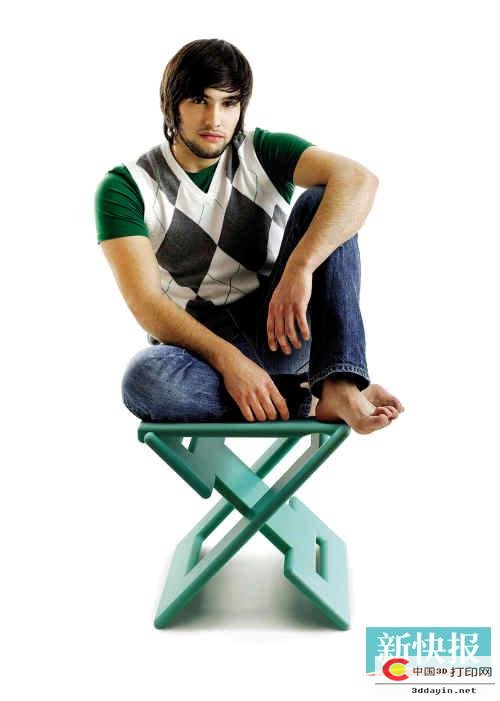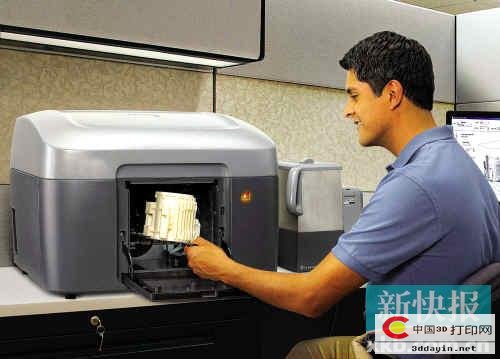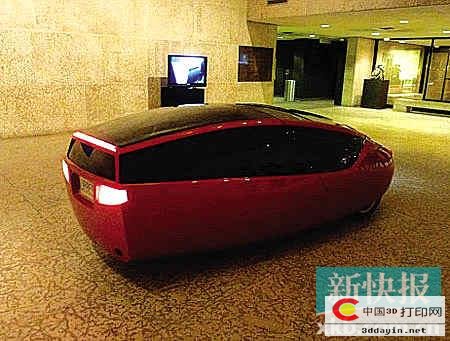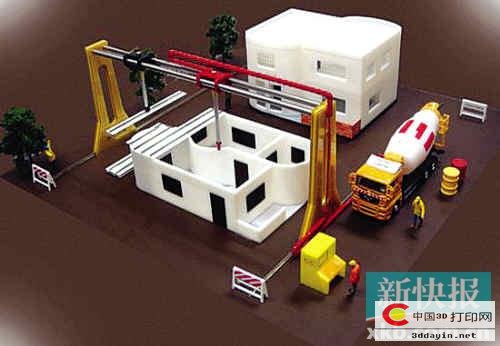
3D printed dolls

3D printer is printing cups


Use a printer to print a form or a photo,
This is just normal today.
Whether laser or inkjet printers,
It has already filled our lives.
How is it like "My pen Ma Liang"?
Print a car, a car that can move,
Or simply print an iPhone directly.
Nor do you have to compete with the “cattle party†to grab it.
This magical "pen" is 3D printing technology.
Known as a technology that subverts traditional manufacturing.
Imagine if your family had a 3D printer one day.
Simple as a hook, a small device,
As complicated as a wall clock, even televisions can be printed.
Do you still need to go shopping?
â– New Express reporter Hong Wenfeng
1
universal!
What can be printed in 3D printing?
Let's take a look at how amazing 3D printing is. It can print out many things you can't imagine, like a car! Yes, 16 senior engineers from Belgium formed a team of “New Generation Engineers†to design a 3D racing car called “Areion†which can increase the speed from 0 to 60 miles in 4 seconds. / Hour, the maximum speed in driving can reach 87 mph. To print this 3D car, you have to start with the shell and pass the designed 3D digital model to the 3D printer. After a long wait, the whole shell structure is printed out and even printed on both sides of the car. Complex cooling channels; then, combined with integrated chips, fitted with tires and engines, the team completed the printing of the 3D car within three weeks.
Another 3D-printed car, called Urbee, also recently made its debut in Canada. It is a three-wheeled, two-seater hybrid car powered by batteries and gasoline. Although the brake power of a single-cylinder engine is only 8 horsepower, due to its compactness and lightness, the maximum speed can reach 112 kilometers per hour. The "Urbee" orange-red body has a flat, oval shape that is small and cute. The chassis is made of stainless steel. All external components, including glass panels, are produced by large-scale 3D printing equipment. The advanced 3D printing technology not only makes Urbee fashionable and streamlined appearance, but also reduces the waste of raw materials in the manufacturing process. It can be described as a truly eco-friendly model.
What's more amazing? Print the bald eagle's embarrassment and give it an artificial "righteousness." A vulture named "beautiful" was hit by a poacher on the face with a gun. He was seriously injured and could not eat himself. The volunteer of the non-profit organization "Birds of Prey Northwest" feeds it with a pipe, but its embarrassment will never grow. This means that "beautiful" will forever lose its ability to eat and face euthanasia. fate. Raptor expert Jenkins Contewell, a joint mechanical engineer, and a dentist, designed a nylon polymer cartridge that could completely replace the “beautiful†lost upper jaw. The “pros and cons†were printed using a 3D printer. Although the "beautiful" new pimple after surgery is not perfect, it can at least eat itself.
Printing a house is not a fantasy. Professor Behrokh Khoshnevis of the University of Southern California is conducting a study to build a 3D printer that can print a house in one day. It takes only 20 hours to complete! The huge 3D house printer will start from the foundation of the house. Floors, walls, ceilings, pipes and even more advanced things, such as wires, can be printed. The designer only needs to design CAD drawings of the doors and windows. The others will stay. Give a huge 3D printer. Don't worry that the printed "plastic house" is very fragile. Prof. Behrokh Khoshnevis thinks that by 2050, 3D printing houses will no longer be a rare thing, and at that time there is no need to worry about the firmness of the house. The average house is for 30 years - It will be rebuilt in 50 years. Now that various kinds of high-strength plastics produced can guarantee the use of 5 years to 10 years, there is no problem. The key is low cost. People can change their new house in a few years.
2
magical!
3D printing is the original
Well, after seeing the universal 3D printing, you must be very interested to know how it is implemented. In fact, it is said that 3D printing is the same as the 2D printing principle we are familiar with, except that 3D printing does not eject ink, but special materials, and this technology actually appeared in the 1990s.
Using a 3D printer is like printing a letter: tapping on the "Print" button on a computer screen, a digital file is sent to an inkjet printer, which sprays a layer of ink onto the surface of the paper to form a picture. Two-dimensional image. In 3D printing, the software performs a series of digital slicing through Computer Aided Design (CAD) technology and sends the slicing information to a 3D printer, which stacks successive thin layers until a solid object is formed. The biggest difference between a 3D printer and a traditional printer is that the "ink" it uses is a real raw material.
There are many ways to change the print to 3D, and some 3D printers use the "inkjet" method. For example, a thin layer of liquid plastic material is sprayed on a mold tray using a printer nozzle. The coating is then exposed to ultraviolet light; the mold tray is then lowered a minimum distance for the next layer to stack up. There are also some 3D printing systems that use powder particles as a print medium. Powder particles are sprayed on the mold tray to form an extremely thin layer of powder which is then cured by the ejected liquid adhesive. It can also be cast into a given shape using a technique called "laser sintering". When complex structures including holes and cantilevers are encountered, gels or other substances need to be added to the media to provide support or to occupy space. This part of the powder will not be cast, and finally the pores can be formed only by flushing the support with water or an air stream. The types of media that can be used today for 3D printing vary from a wide variety of plastics to metals, ceramics, and rubber-like materials. Some printers can also combine different media so that printed objects are hard and soft on the other. Scientists are using 3D printers to create simple living tissues such as skin, muscle, and blood vessel fragments. It is possible that one day we will be able to create large human organs such as kidneys, liver, and even the heart. If the bioprinter can use the patient's own stem cells, the rejection after organ transplantation will decrease. People can also print foods. For example, scientists at Cornell University have successfully printed cupcakes. Almost everyone believes that the killer app in the food industry will be a machine that can print chocolate.
If we want to make a plastic apple, we first need to use CAD software on the computer to make an Apple 3D model file, and then convert it to a file format supported by the 3D printer. Next you need to put plastic supplies into the 3D printer, then click "Print" and the rest will go to the 3D printer. And so on, there is one important point to note, is the 3D printer will divide the apple into layers to print? One of the simplest logic is that the more layers there are, the higher the accuracy of the printed apple. For example, the closer the arc is to the natural, this is somewhat similar to the resolution principle of digital photographs. The number of print layers is actually determined by the "layer thickness" of the 3D printer. The more advanced 3D printers can print thinner layers, and the layer thickness is usually micron-level, which is also important for measuring the performance of 3D printers. standard. However, it is confusing that the smaller the layer thickness, the higher the precision and the slower the 3D printing speed. It can be said that fish and bear's paw can not have both.
3
Great!
3D printing will disrupt traditional manufacturing
Americans even started to use the idea of ​​printing an iPhone with a 3D printer, because this new manufacturing technology will subvert the traditional production model, do not need a lot of workers to do the same product, repeat the same production work, these are handed over to 3D printers to do, imagine what Foxconn employees for Apple's production of i-Phone compete with 3D printer production efficiency, maybe someday Americans use their own 3D printer to print out the cost of the iPhone will be lower than today's Foxconn production. In fact, with the current 3D printing technology, displays and sensors that appear to be "high-precision" components can be printed directly. So, are we far from the day of direct printing iPhone?
This is a simple truth. If we can use the machine to do things, why do we still need to artificially produce? 3D printing technology has changed the traditional manufacturing process. People no longer need to manufacture batches of different parts in batches, and then assemble them together, but only need to do a great design, and the rest is left to 3D. Completed by the printer, this machine can break the concept of parts and print the whole product directly. Obviously, the manufacturing process of 3D printing can not only save a lot of human labor, but also maximize the use of materials.
However, the current 3D printing can only be used in the unconventional manufacturing field. For example, companies can print a sample in 3D for customers, but they cannot deliver large quantities of printed products out to customers, and 3D printing technology still has Big constraint bottleneck. The biggest one is the issue of consumables. Imagine printing a plastic apple. It's a very simple matter. You only need to add some plastic raw material to the 3D printer, but if you really want to print iPhone, you'll need aluminum, glass, plastic, and each With conductive materials, printing polymer lithium batteries also looks like a thorny issue. The use of so many different material consumables on a 3D printer is currently technically difficult.
However, technical difficulty can not prevent 3D printing from being sought after. The British "Economist" magazine believes that it will promote the third industrial revolution together with other digital production models. The vision of replacing large numbers of workers with 3D printers will one day be met. arrival.
Q&A
Q: Is the 3D printer universal? A: At least the current 3D printer is not a panacea. Its production products are constrained by raw material consumables. If material science breakthroughs, it will be more perfect.
Q: Will 3D printers replace traditional manufacturing?
A: It does not seem that at present, it can change some aspects of the traditional production process to make it more efficient and cost-effective.
Q: Can 3D printers print out color directly?
A: Many professional-grade and production-grade 3D printers have been able to directly print out colored items. Personal-grade 3D printers can produce monochromatic items by selecting colored materials.
Q: Why is the 3D printer expensive?
A: The market for 3D printer products is divided into individual, professional, and production grades. The structure and technology and consumables are different, so the price gap is very large. There are several thousand dollars worth hundreds of thousands of dollars.
Try it
3D printing for individuals can also play
Well, see if you are drooling here? Try to print a bicycle yourself, or design a couple of dolls that you own, and even want to own a personal desktop 3D printer. There are still ways. Although the current top 3D printing technology is affordable for large companies, the price of tens of thousands of dollars is really high. However, for individual players or small businesses, there is still a way to try this new type of 3D printing.
At present, there have been some 3D printing services for individuals or small businesses in China. Customers only need to provide them with well-designed 3D graphics. They can print for them, and the printed gadgets do not cost too much. For example, a small sports car model printed out with a 3D printer usually costs about 400 yuan. Even if you are a design professional, then it is also possible to have a desktop 3D printer. Usually the price is only 3,000 yuan - 5,000 yuan. Of course, this personal level 3D printer function is very simple, usually only Can use plastic consumables, the most suitable for printing small designs.
In fact, 3D printers are also moving toward miniaturization. Some U.S. companies have already launched desktop 3D printers for individuals and small business users. The price is usually below $2,000, and the cheaper models are as low as $400. In China, there are companies that specialize in personal 3D printers. The price of domestic brands' 3D printers only needs a few thousand dollars, but the function is relatively simple.
Some analysts believe that 3D printers are just like PCs in the past. Only a small number of technicians needed to use PCs at the beginning. However, when PC applications become popular, PCs have ushered in the era of popularization of millions of households. The same is true for 3D printers. When people discover that it can print many items used by people in their daily lives, 3D printers also have the opportunity to enter millions of households.
(Editor)
Faux Mink Russian Lashes,Classic Russian Lashes,Natural Russian Lashes,Russian Volume Lashes
Zhengzhou Cuka Electronic Commerce Co., Ltd. , https://www.cukalashes.com